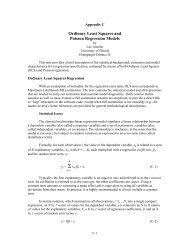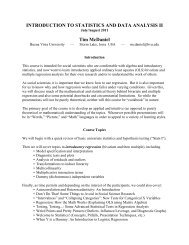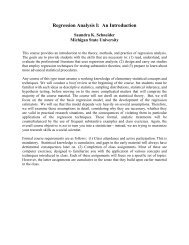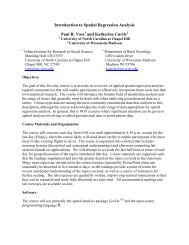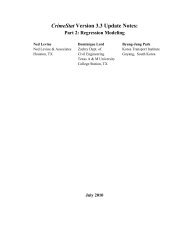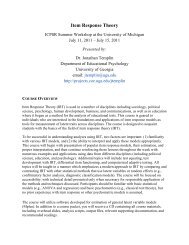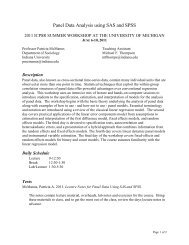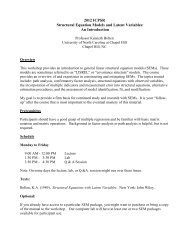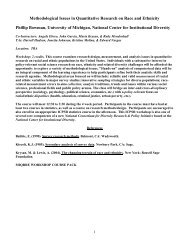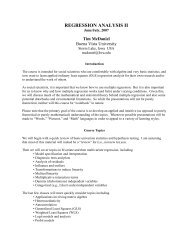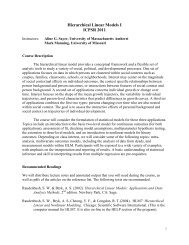Network Analysis: An Introduction - icpsr - University of Michigan
Network Analysis: An Introduction - icpsr - University of Michigan
Network Analysis: An Introduction - icpsr - University of Michigan
You also want an ePaper? Increase the reach of your titles
YUMPU automatically turns print PDFs into web optimized ePapers that Google loves.
<strong>Network</strong> <strong><strong>An</strong>alysis</strong>: <strong>An</strong> <strong>Introduction</strong> (One-week Workshop)<br />
July 21-25, 2008<br />
Instructor:<br />
Lab Assistant:<br />
Stanley Wasserman, Indiana <strong>University</strong> Bloomington<br />
stanwass@indiana.edu<br />
<strong>An</strong>n McCranie, Indiana <strong>University</strong> Bloomington<br />
amccrani@indiana.edu<br />
Course Description<br />
<strong>Network</strong> analysis focuses on relationships between social entities. It is used widely in the<br />
social and behavioral sciences, as well as in political science, economics, organizational science,<br />
and industrial engineering. The social network perspective, which will be taught in this<br />
workshop, has been developed over the last sixty years by researchers in psychology, sociology,<br />
and anthropology. The social network paradigm is gaining recognition and standing in the<br />
general social and behavioral science communities as the theoretical basis for examining social<br />
structures. This basis has been clearly defined by many theorists, and the paradigm convincingly<br />
applied to important substantive problems. However, the paradigm requires a new and different<br />
set <strong>of</strong> concepts and analytic tools, beyond those provided by standard quantitative (particularly,<br />
statistical) methods.<br />
This five-day workshop covers precisely those concepts and tools. The course will<br />
present an introduction to various concepts, methods, and applications <strong>of</strong> social network analysis<br />
drawn from the social and behavioral sciences. The primary focus <strong>of</strong> these methods is the<br />
analysis <strong>of</strong> relational data measured on groups <strong>of</strong> social actors. Topics to be discussed include an<br />
introduction to graph theory and the use <strong>of</strong> directed graphs to study structural theories <strong>of</strong> actor<br />
interrelations; structural and locational properties <strong>of</strong> actors, such as centrality, prestige, and<br />
prominence; subgroups and cliques; equivalence <strong>of</strong> actors, including structural equivalence,<br />
blockmodels, and an introduction to role algebras; an introduction to local analyses, including<br />
dyadic and triad analysis; and statistical global analyses, using models such as p1, p*, and their<br />
relatives. The workshop will also cover more specific applications in common s<strong>of</strong>tware packages<br />
for network analysis: UCINET, Pajek, STOCNET, and pnet.<br />
Prerequisites for this workshop are familiarity with matrix algebra. A background<br />
in linear models and categorical data analysis will be helpful, but not required.<br />
1
Schedule<br />
The workshop will meet for about seven hours each day at <strong>University</strong> <strong>of</strong> <strong>Michigan</strong>, according to<br />
the following schedule:<br />
Time<br />
Morning<br />
Early afternoon<br />
Late afternoon<br />
Activity<br />
Lecture<br />
Computing and Data <strong><strong>An</strong>alysis</strong> (with <strong>An</strong>n)<br />
Questions and Discussion<br />
Course texts<br />
There are two particularly helpful texts for this class. The Wasserman & Faust text will be<br />
primary.<br />
Wasserman, S., and Faust, K. (1994). Social <strong>Network</strong> <strong><strong>An</strong>alysis</strong>: Methods and Applications.<br />
Cambridge, ENG and New York: Cambridge <strong>University</strong> Press.<br />
Carrington, P., Scott, J, and Wasserman, S. (2004). Models and Methods for Social <strong>Network</strong><br />
<strong><strong>An</strong>alysis</strong>. New York: Cambridge <strong>University</strong> Press.<br />
Additionally, you may find the following texts helpful:<br />
Wasserman, S., and Galaskiewicz, J. (1994). Advances in Social <strong>Network</strong> <strong><strong>An</strong>alysis</strong>: Research<br />
from the Social and Behavioral Sciences. Newbury Park, CA: Sage.<br />
Monge, P., and Contractor, N. (2003). Theories <strong>of</strong> Communication <strong>Network</strong>s. New York:<br />
Oxford <strong>University</strong> Press.<br />
Knoke, D., and Yang, S. (2007). Social <strong>Network</strong> <strong><strong>An</strong>alysis</strong>, Second Edition. Newbury Park, CA:<br />
Sage.<br />
Topics to be taught and the relevant chapters from Wasserman and Faust are:<br />
Chapter 1: <strong>Introduction</strong><br />
Chapter 2: Social <strong>Network</strong> Data: Collection and Applications<br />
Chapter 3: Notation for Social <strong>Network</strong> Data<br />
Chapter 4: Graphs and Matrices<br />
Chapter 5: Centrality, Prestige, Prominence, and Related Concepts<br />
2
Chapter 7: Cohesive Subgroups<br />
Chapter 9: Structural Equivalence<br />
Chapter 10: Blockmodels<br />
Chapter 13: Dyads<br />
There will also be some readings from Carrington, et al.<br />
Please review chapters 1-3 before you arrive in <strong>An</strong>n Arbor.<br />
Computer Programs<br />
We will be using a number <strong>of</strong> different social network analysis computer programs. All <strong>of</strong> these<br />
are available in the computer labs. All but UCINET are freely available on the web.<br />
UCINET, available in computer labs and for purchase from <strong>An</strong>alytic Technologies:<br />
http://www.analytictech.com<br />
Pajek: http://vlado.fmf.uni-lj.si/pub/networks/pajek/default.htm<br />
Netdraw, comes with the UCINET package or individually at: http://www.analytictech.com<br />
STOCNET: http://stat.gamma.rug.nl/stocnet/ (see also<br />
http://stat.gamma.rug.nl/snijders/siena.html)<br />
pnet: http://www.sna.unimelb.edu.au/pnet/pnet.html<br />
<strong>Network</strong> Workbench: http://nwb.slis.indiana.edu/download.html<br />
Other Resources<br />
These are some particularly useful resources on social networks available online.<br />
The International <strong>Network</strong> for Social <strong>Network</strong> <strong><strong>An</strong>alysis</strong> (INSNA) is the international and<br />
interdisciplinary pr<strong>of</strong>essional association for people interested in social network research. Its<br />
website (http://insna.org ) is a wonderful source <strong>of</strong> information and resources on social networks,<br />
including links to many informative sites and to social network computer programs and data.<br />
Complexity and Social <strong>Network</strong>s Blog (http://www.iq.harvard.edu/blog/netgov/ ) is a new “online<br />
journal” devoted to network analysis.<br />
The listserv, SOCNET, is the main on-line forum for discussion <strong>of</strong> current topics on social<br />
networks. Information on how to join is available through the INSNA site (see above) or at:<br />
http://insna.org/INSNA/socnet.html<br />
3
Connections is INSNA’s newsletter/ informal journal. It is available through the INSNA website<br />
or directly at: http://insna.org/indexConnect.html<br />
Journal <strong>of</strong> Social Structure is an peer-reviews online journal with many articles <strong>of</strong> interest to<br />
social network researchers. http://www.cmu.edu/joss/<br />
Steve Borgatti’s web page is a nice source <strong>of</strong> introductory material and handouts on various<br />
topics on social networks. http://www.analytictech.com/networks/<br />
Data examples from Wasserman and Faust are available at the INSNA website.<br />
4



